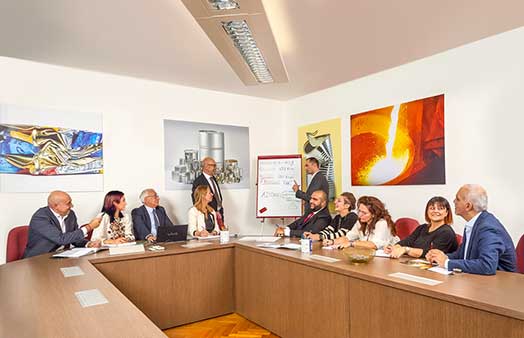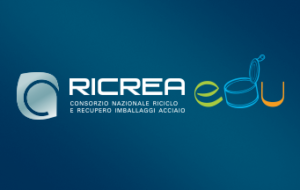There are two steel production processes: integral cycle (based on blast furnaces) and electric arc steelmaking. They are described below.
Integral cycle and electric arc steelmaking
Integral cycle (blast furnace) steelmaking
The production of blast furnace steel relies on a chemical reduction reaction. The heart of the cycle is the blast furnace, into which iron ore, coke and limestone and a variable percentage of scrap (depending on the type of steel to be produced) are loaded. After suitable heating, cast iron is produced.
Subsequently, the cast iron is refined in special oxygen converters, obtaining liquid steel, which is given shape through a continuous casting plant or in special ingot moulds. The semi-finished products obtained can be marketed or further processed in rolling mills.
IRON
Integral-cycle steel is obtained using iron ore, extracted from mines.
Iron is the most common mineral on Earth, making up 16% of its mass. The maximum concentration of iron is in the Earth’s core, while the percentage in the crust is only 4.75%. Most iron is found in minerals made up of various iron oxides, including haematite, magnetite, limonite and taconite. Iron ore mining, which makes up over 95% of the global mining industry, produces over 2.2 billion tonnes annually. The main mines are located in Australia (about 35% of world production), Brazil (17%) and China (16%).
Integral-cycle steelmaking creates flat, laminate sheets, semi-finished products used to produce sheet metal for vehicles, ships, furniture, electrical appliances, packaging and pipes.
The semi-finished product used for the production of steel packaging is a laminate that is marketed in coil form.
After delivery to the steel packaging manufacturing companies, the coil is unrolled and cut to the size of the container to be produced. The laminate can be of two types: electrolytic tinplate and chrome plate.
Electric arc steelmaking
In this process, the raw material is steel scrap. Scrap pieces are processed to reduce them to the desired dimensions and then placed in a furnace. Here they are melted by the heat from an electric arc generated between three graphite electrodes and the underlying scrap. In this way, semi-finished products called “long products” are obtained, i.e. beams and bars for reinforced concrete, rails, hardware products, wire rods and street furniture products.
Production of steel packaging
The semi-finished product used for the production of steel packaging is a laminate that comes out of the steel mills as a coil.
After delivery to the steel packaging manufacturing companies, the coil is unrolled and cut to the size of the container to be produced. The laminate can be of three types: electrolytic tinplate, chrome plate and black plate.
Electrolytic Tinplate
Universally known as tinplate, this material is a sheet of steel covered on both sides with a thin layer of tin of varying thickness.
The superficial tin layer is an effective protective barrier, which gives the content the utmost hygienic guarantee, preventing it from coming into direct contact with the steel. It is used for food products.
Chrome plate
Chrome plate is an alternative material to tinplate and has a different coating. Chrome plate is steel coated with chromium and chromium oxides. It is mainly used in the production of bases and lids and of crown caps.
Black plate
Black plate (or steel sheet or sheet metal) is cold-rolled steel, not coated with other materials, with excellent oxidisability qualities and considerable resistance to mechanical stress; it can be protected with any type of varnish. It is the ideal material for making large drums.
Use of steel packaging
Steel packaging can contain food and non-food products: nowadays the variety of preserved products is truly vast.
Steel packaging is currently used to preserve – in addition to tomatoes, jellied meat and oil – food such as beans, chickpeas, broad beans, peas, lentils, boiled green beans, potatoes, corn, carrots, asparagus, cucumber, mushrooms, vegetables in brine, fruit in syrup, biscuits, tuna and mackerel in oil and water, anchovies and sardines in oil and salted, salmon pâté, chopped meat (including crab meat), ready-made tripe with sauce, whole and pitted olives, ground spices, granulated vegetable and meat stock, dog and cat food, candies, soft drinks, beer, liqueurs, coffee, instant barley, tea and cream.
Steel containers are widespread throughout the world and, depending on the country, can contain the most diverse foods. These include, in Germany, plain sauerkraut and some types of pickled frankfurters, in England, turtle soup, in the United States, moose meat and buffalo meat with beans, in Japan, whale meat and blowfish in sake, in China, bamboo shoots and shark fin soup, in South Africa, crocodile meat, in Botswana, worms of the mopani tree in brine, in Norway, herring in oil and reindeer meat, in Canada, seal meat, and in France, lobster bisque. In short: there is something for all tastes.
Steel packaging is not just for storing food products. Even inedible products need to be packaged to preserve their contents over time. Cigars, once stored in wooden boxes, are among the non-food products preserved in steel; paints and mineral oils, used as lubricants for engines, are also stored in steel buckets. Steel is also used to make spray cans for household cleaning, personal hygiene and cosmetic products. The crown caps of beer bottles and the lids of glass jars are also made of steel. Last, but not least, steel is used for the 200 litre drums containing lubricants, paints, petroleum, etc.



